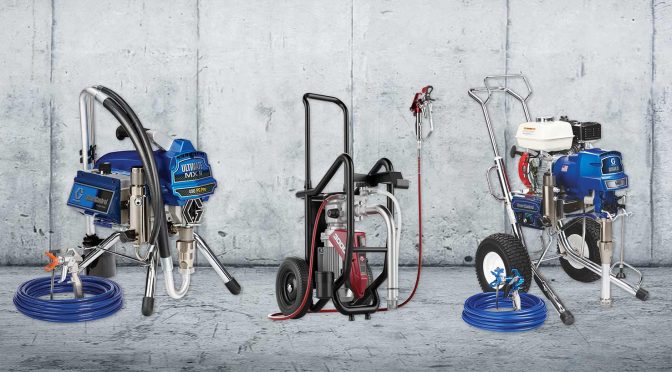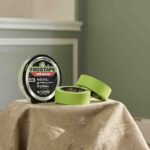Selecting the right sprayer can improve efficiency and productivity, but only if it’s the right one. This article will help you get the information you need before you buy.
It’s all about being more productive
A new paint sprayer can improve your efficiency, maximize your productivity, and deliver a finish that your customers will notice, say product specialists with Graco and Titan Tool, manufacturers of premium paint sprayers that can be found at Sherwin-Williams stores.
In fact, sprayers get the job done three to four times faster than traditional rollers and up to 10 times faster for high-production commercial jobs. But you’ll only realize such productivity gains if the sprayer you’ve chosen aligns with your needs.
The following are considerations and key questions to ask, the answers to which will help you dial in your sprayer needs.
1. What exactly do you paint most?
Start by thinking about the things you paint most frequently. Is it large, flat surfaces, such as walls, ceilings, warehouse exteriors, fencing or sound barriers? Airless sprayers are the answer in that case. However, if you find your team frequently painting smaller, irregular-shaped objects — molding, furniture, cabinet doors, handrails — a high-volume, low-pressure (HVLP) sprayer may be your answer. And if you demand the speed of an airless sprayer combined with the precision of HVLP, as in production environments, air-assisted airless sprayers could be for you.
“In very general terms, airless sprayers can be viewed as substitutes for rollers, and HVLP sprayers as substitutes for brushes,” says Chris Noto, the Director of Professional Products at Titan. “We’ve found that among painting contractors, about 73 percent of paint sprayer usage falls into the airless category.”
Each of these types of sprayers have unique considerations, but with 73 percent of contractor paint sprayer usage falling into the airless category, this article will focus on selecting the right airless sprayer.
2. What types of work do you do?
Or rather, where are you working? Residential? Commercial? New construction? Depending on the types of jobs you are completing, different sprayers may provide different benefits. An entry-level sprayer would likely provide extra productivity on a residential exterior, but wouldn’t be sufficient for an industrial dryfall project.
3. What types of coatings are you applying?
The types of coatings you are using often depends on the jobs you are completing. A latex wall paint will require different maximum fluid pressure and gun requirements than lacquers, elastomerics, or texture.
“The types of work and coatings are important to consider upfront, as they start to narrow the end-user’s options,” says Graco Director of Sales Brandon Barth. “There are a lot of choices out there when it comes to airless sprayers, and it’s rarely a ‘black-and-white’ decision. Sometimes it’s very specific to the work you’re doing and the coatings being applied. And sometimes it’s simply a matter of end-user preference.”
4. How much paint will you be spraying?
Volumes are typically expressed in terms of gallons per week, and Noto estimates that a contractor spraying up to 50 gallons per week consider an entry-level sprayer capable of spraying up to ½ gallon per minute (gpm); 50-100 gallons per week consider a mid-sized sprayer capable of spraying more than ½ gpm, and a contractor spraying more than 100 gallons per week consider a large sprayer with capacities of about 1 gpm. Also consider the tip size that will be the best fit for your operation. Tip sizes will also play a key role in dictating volumes and sprayer selection — look for a separate article on spray tip selection in an upcoming PRO email.
5. What power source do you need?
Think about your projects and job sites, and then decide what power source are available and/or best fit your operation. Airless sprayers are available in gas or electric models, and some have the capability to convert from electric to gas, giving you options. New battery-powered airless sprayers are coming to market, using rechargeable Lithium Ion batteries, providing even more power options and flexibility. Choose gas or battery-powered if you don’t have regular access to electricity. Choose electric if working inside or with regular access to power.
6. What are your hose length requirements?
Some jobsites won’t allow you to move your pump easily — such as new residential construction — and extending your hose will be important. The longer the hose you use, the greater the effects of friction within the hose, increasing the demands on your sprayer unit, so look for units with higher-than-required maximum pressure to ensure sufficient pressure at the tip. Additionally, gravity will increase the demands on sprayer power if, for example, your hose is extending two stories higher than your sprayer unit.
7. What’s your budget?
Price, of course, will be a primary driver in any sprayer purchase decision but both Barth and Noto advise that purchasers consider some greater return-on-investment (ROI) and lifetime ownership calculations before simply turning to a lower-priced model.
“It is important, of course, that an end-user gets the quickest ROI possible, but buyers need to think about their long-term needs,” says Barth. “Consider purchasing a sprayer that you can grow your business with, which might mean capacity to support more than one gun or produce a higher flow rate, both of which would increase your efficiency.”
Adds Noto: “Consider the size not only of your current crew, but your future crew, so that your sprayer decision supports your business growth plans. You may want to buy a sprayer that’s a step above your current volume requirements, because having to use an undersized sprayer after your needs have changed will cost you more in frustration, repairs and downtime. That will eventually erase any upfront savings you may have realized on the purchase price.”
The bottom line
Talk to your Sherwin-Williams sales rep before making a sprayer decision. But be prepared to discuss answers to all the above questions to ensure you purchase the right sprayer for your present needs — and the future. It’s not just when you are buying a new sprayer — it’s always important to regularly assess how your project requirements and productivity needs have evolved, and whether a new airless sprayer may help you be more efficient. Getting a sprayer that maximizes your efforts on a jobsite and delivers a finish that matches your reputation is an investment in your business.
Read more stories about paint products and application techniques in the Pintor Pro magazine archive.




